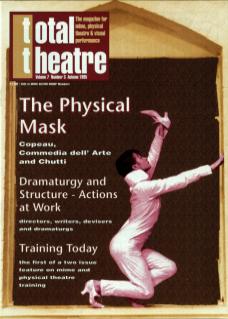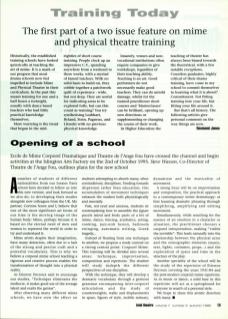A number of students of different nationalities from our former Paris school have decided to follow us into this new venture, and look forward, as we also do, to developing their studies alongside new colleagues from the UK. My partner, Corinne Soum, and I believe that one of the most significant artforms of our time is the moving image of the human body: Mime, perhaps because it is based on the eternal need of men and women to represent the world in order to try and understand it.
Mime artists, despite their imagination, have many detractors, often due to a lack of the strong and precise craft and a powerful vocabulary. This is why we believe a corporeal mime school teaching a rigorous and creative process enables the transformation of thought into a physical reality.
As Étienne Decroux said to encourage our studies, ‘Technique eliminates the mediocre, it makes good use of the average talent and exalts the genius.’
After observing many different mime schools, we have seen the effect on students attempting to absorb many, often contradictory, disciplines. Tending towards dispersion rather than education, this accumulation of movement techniques exhausts the student both physiologically and mentally.
Pale, red-eyed and anxious, students sit contemplating how to assemble the jigsaw puzzle mind and body parts of a bit of mime, dance, fencing, acrobatics, acting, cooking, jazz-noh fusion, ballroom swinging, automatic writing, Greek tragedy...
Instead of floating from one technique to another, we propose a study centred on a strong central point: Corporeal Mime. This training will be divided into several areas: technique, improvisation, composition and repertoire. The student will study in-depth the different perspectives of one discipline.
With the technique, they will develop a dramatic vocabulary through a gestural grammar encompassing inter-corporeal articulation and the study of counterweights, walks and displacements in space, figures of style, mobile statuary, dynamism, and the musicality of movement.
A strong focus will be on improvisation and composition, the practical approach to a contemporary mime dramaturgy: at first learning dramatic phrasing through simplifying, amplifying and editing movement.
Simultaneously, while searching for the essence of an emotion in a character or situation, the practitioner chooses a corporeal interpretation, making ‘visible the invisible’. This leads naturally into the relationship between the physical actor and the scenographic elements (music, text, lights, costumes, props...) and the exploration of space and time in the structure of the play.
Another speciality of the school will be the study of the repertoire of Étienne Decroux covering the years 1931-84 and the post-modern corporeal mime repertoire. As in music or dance, a solid base in this repertoire will act as a springboard for everyone in search of a personal style.
We hope to share this artistic direction with many.

